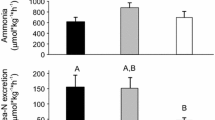Summary
A radiotracer technique involving 51Cr was used to monitor the egestion rates of A. fluviatilis and P. contortus.
When snails were starved, either before or after exposure to labelled food, gut emptying rate reduced. Examination of faecal components suggested that this was due to reductions in the rate of passage of food through the hepatopancreas. Since the latter is the major site of digestion and absorption in the Gastropoda this strategy was explained as an attempt by the snails to extract more nutrient from the disturbed food supply. Other factors affecting egestion rate were, temperature, food quality and snail size. Weight for weight egestion was more rapid in P. contortus than in A. fluviatilis and this difference is typical between detrivores and herbivores.
Information on defaecation strategy enabled an estimation of field absorption and ingestion rates in A. fluviatilis. There was good agreement between the latter and estimates predicted on the basis of laboratory observation. However, field determined absorption efficiencies were more constant and generally higher than those predicted on the basis of laboratory measurements.
Similar content being viewed by others

References
Avery, R. A.: Morphometric and functional studies on the stomach of the lizard Lacerta vivipara. J. Zool. (Lond.) 169, 157–167 (1973)
Calow, P.: Studies on the natural diet of Lymnaea pereger obtusa (Kobelt) and its possible ecological implications. Proc. malacol. Soc. Lond. 39, 203–215 (1970)
Calow, P.: The structural and functional dynamics of selected species-populations of freshwater snils; towards a systems approach. Unpublished Ph. D. thesis, University of Leeds (1972)
Calow, P.: The food of Ancylus fluviatilis Müll., a littoral, stone-dwelling herbivore. Oecologia (Berl.) 13, 113–133 (1973a)
Calow, P.: On the regulatory nature of individual growth: some observations from freshwater snails. J. Zool. (Lond.) 170, 415–428 (1973b)
Calow, P.: Evidence for bacterial feeding in Planorbis contortus Linn. Proc. malacol. Soc. (Lond.) 41, 145–156 (1974a)
Calow, P.: Some observations on the dispersion patterns of two species-populations of littoral, stone-dwelling gastropods (Pulmonata). Freshwat. Biol. 4, 557–576 (1974b)
Calow, P.: The feeding strategies of two freshwater gastropods, Ancylus fluviatilis Müll. and Planorbis contortus Linn. (Pulmonata), in terms of ingestion rates and absorption efficiencies. Oecologia (Berl.) 20, 33–49 (1975a)
Calow, P.: On the nature and possible utility of epilithic detritus. Hydrobiologia (in press, 1975b)
Calow, P., Fletcher, C. R.: A new radiotracer technique involving 14C and 51Cr for estimating the assimilation efficiences of aquatic primary consumers. Oecologia (Berl.) 9, 155–170 (1972)
Carriker, M. R.: Observations on the functioning of the alimentary system of the snail Lymnaea stagnalis appressa Say. Biol. Bull. mar. biol. Lab. Woods Hole 91, 88–111 (1946)
Chipman, W. A.: Some aspects of the accumulation of 51Cr by marine organisms. In: Radioecological concentration processes, B. Arberg, F. P. Hungate, eds., pp. 931–941. Oxford-London-Edinburgh-New York-Toronto-Sydney-Paris-Braunschweig: Pergamon Press 1966
Cleland, D. M.: A study of the habits of Valvata piscinalis (Müller) and the structure and function of the alimentary canal and reproductive system. Proc. malacol. Soc. Lond. 30, 167–203 (1954)
Conover, R. J.: Assimilation of organic matter by zooplankton. Linmol. Oceanogr. 11, 338–345 (1966)
Elliott, J. M.: Rates of gastric evacuation in brown trout, Salmo trutta L. Freshwat. Biol. 2, 1–18 (1972)
Foster, R. F.: Environmental behaviour of chromium and neptunium. In: Radioecology, V. Schulz, A. W. Klement, Jr., eds., p. 569–576. New York-Washington: Reinhold Publishing Corp. 1963
Heidermans, C.: Über den Muskelmagen der Süßwasser-Lungenschnecken. Zool. Jb. (Abt. Allgemeine Zool. u. Physiol. der Tiere) 41, 335–424 (1924)
Hubbell, S. P., Sikora, A., Paris, O. H.: Radiotracer, gravimetric and calorimetric studies of ingestion and assimilation rates of an isopod. Hlth Phys. 11, 1485–1501 (1965)
Macfadyen, A.: Methods of investigation of productivity in invertebrates in terrestrial ecosystems. In: Secondary productivity of terrestrial ecosystems, vol. 11, K. Petrusewicz, ed., p. 383–412. Warszawa Krakow: Panstowe Wydawnictwo Naukowi 1967
Mason, C. F.: Food, feeding rates and assimilation in woodland snails. Oecologia (Berl.) 5, 215–239 (1970)
Ueckert, D. N., Hansen, R. M.: Egestion time of grasshoppers determined by a microscopic technique. J. econ. Ent. 65, 1263–1265 (1972)
Utley, J. R., Boling, J. A., Bradley, N. W., Tucker, N. E.: Recovery of radioactive chromic oxide from the bovine gastro-intestinal tract. J. Nutr. 100, 1227–1232 (1970)
Author information
Authors and Affiliations
Rights and permissions
About this article
Cite this article
Calow, P. Defaecation strategies of two freshwater gastropods, Ancylus fluviatilis Müll. and Planorbis contortus Linn. (Pulmonata) with a comparsion of field and laboratory estimates of food absorption rate. Oecologia 20, 51–63 (1975). https://doi.org/10.1007/BF00364321
Received:
Issue Date:
DOI: https://doi.org/10.1007/BF00364321



